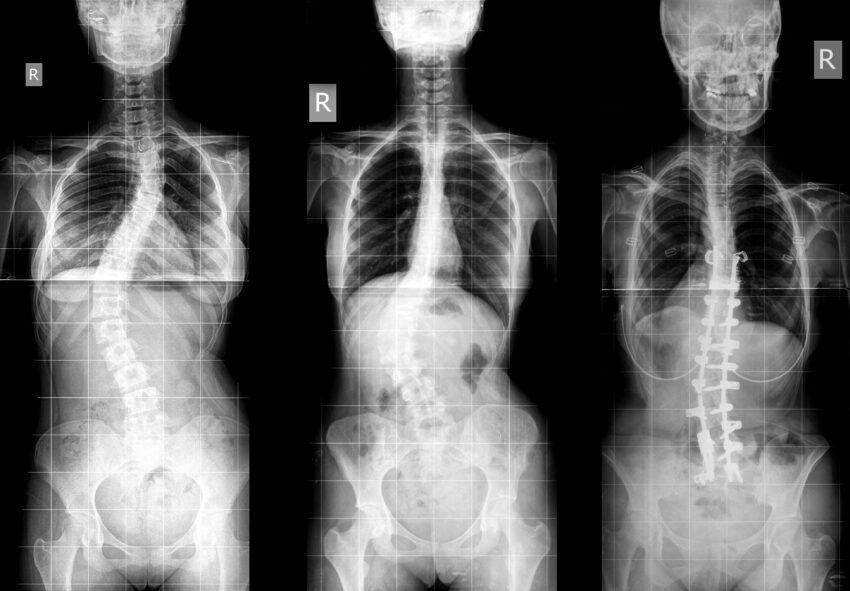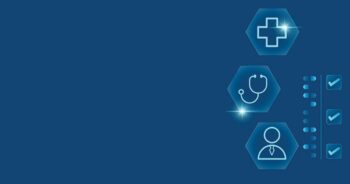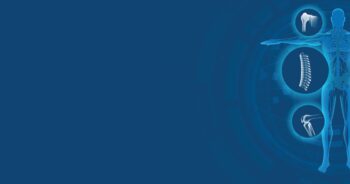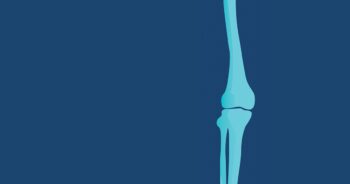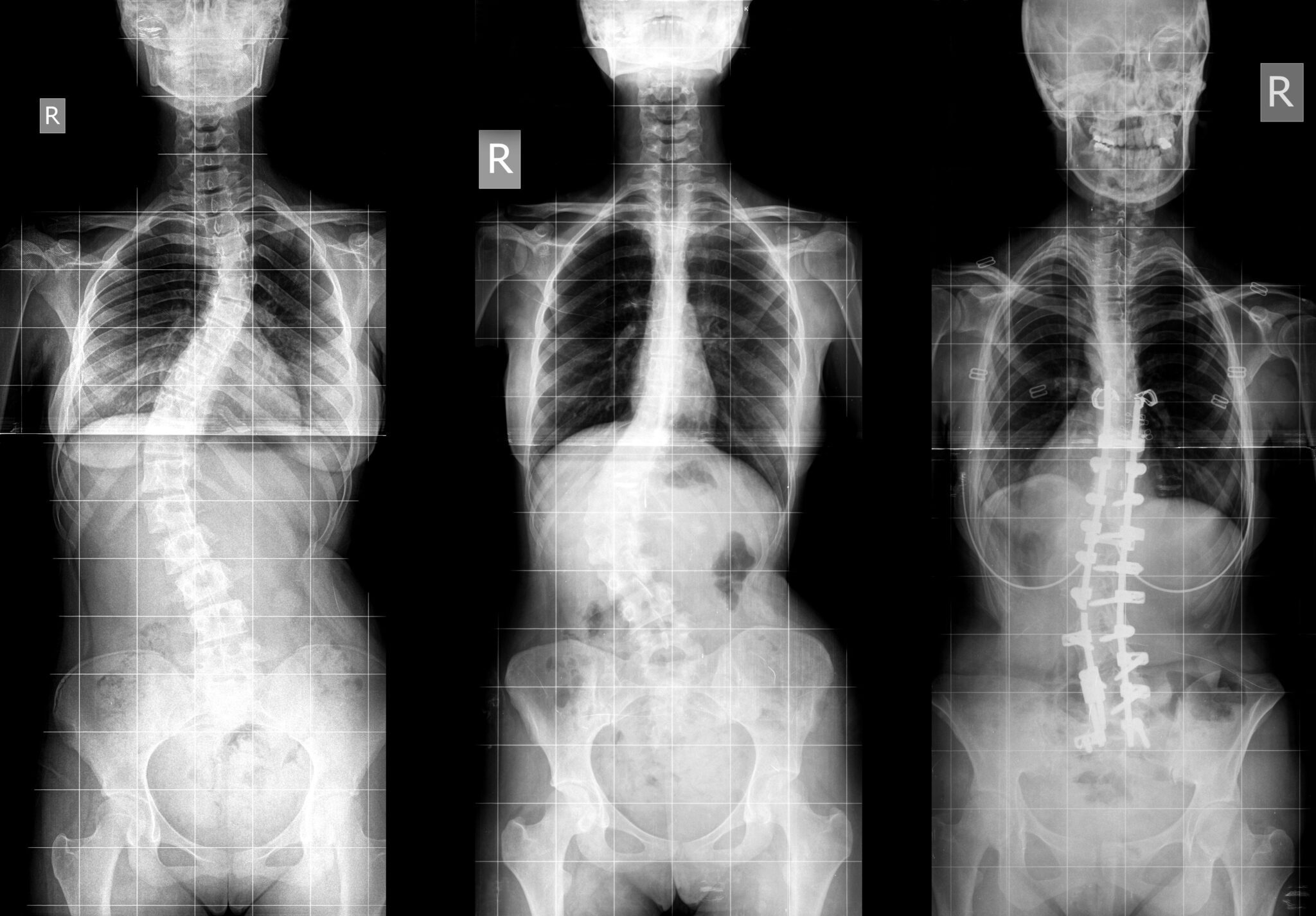
Scoliosis is an abnormal curvature of the spine that affects approximately seven million people in the United States. Adolescent idiopathic scoliosis is most commonly diagnosed between the ages of 10 to 12 years old and may be discovered by parents, during school screenings, or at pediatric visits. When scoliosis is suspected, patients are referred to orthopedic scoliosis specialists who evaluate the patient to determine the severity of the patient’s curvature.
Treatment options for idiopathic scoliosis include observation, bracing, and surgery. In general bracing is recommended for curves between 25-30 degrees in patients with significant growth remaining and corrective surgery is generally reserved for progressive scoliosis curves greater than 45 or curves that do not respond to bracing treatment. The goals of scoliosis correction surgery are to correct the spinal curvature and to prevent the curve from progressing further during the patient’s life.
The involvement of genetic factors in the development of adolescent idiopathic scoliosis has become widely accepted. At present, the general consensus is that the etiology of idiopathic scoliosis is multi-factorial. Exciting new research has recently been presented regarding the use of genetic testing to predict curve progression and failure of brace treatment in patients with adolescent idiopathic scoliosis.
Adolescent Idiopathic Scoliosis (AIS)
Scoliosis is an abnormal curvature of the spine that affects approximately seven million people in the United States. Idiopathic scoliosis is a well characterized condition in humans. Abnormal curvatures of the spine were first recognized by Hypocrites and the name idiopathic scoliosis was introduced in the mid 1900s by Bower. Idiopathic scoliosis is a structural curvature of the spine with lateral and rotatory components which typically affects 2 to 3% of normal children in adolescence.
Severe, progressive curves are rare, and occur in only 0.2 to 0.5% of patients with adolescent idiopathic scoliosis. Adolescent idiopathic scoliosis is most commonly diagnosed between the ages of 10 to 12 years old. It may be discovered by parents, during school screenings, or at pediatric visits. When scoliosis is suspected, patients are referred to orthopedic scoliosis specialists who will evaluate the patient to determine the severity of the patient’s curvature.
Scoliosis is typically characterized by a three-dimensional deformity of the spine that involves a curvature in the sagittal, frontal, and transverse plane. Adolescent idiopathic scoliosis does not typically produce significant morbidity for the patient; however, larger scoliotic curves or curves with significant rotation may cause a bothersome cosmetic deformity. In addition, large scoliotic curves may decrease pulmonary function and in the most severe cases can lead to a type of heart failure known as corpulmonale.
Different factors seem to be related to the risk for curve progression in adolescent idiopathic scoliosis. Specific factors include the age of the patient at the time of diagnosis, the maturity of the patient as determined by menarchal status and Risser sign, and the pattern of the scoliosis curve that is present. In this type of scoliosis, girls are eight times more likely than boys to have curves that progress to a point that treatment is ultimately required.
Treatment options for idiopathic scoliosis include observation, bracing, and surgery. Mild cases of scoliosis are carefully observed with periodic physical examination and x-ray screenings. Most patients are seen on a 4 to 6 month basis until they finish growing and the majority of patients who are observed will have small curves that will have little if any progression as the patient reaches the end of growth. For patients with small curves who are observed, full activities are allowed including competitive sports.
Patients with curves that are at risk for progression during periods of rapid growth may need to be treated with a brace. In general bracing is recommended for curves between 25-30 degrees in patients with significant growth remaining. In most cases, a low profile brace known as a thoracolumbarsacral orthosis (TLSO) is recommended. A number of different bracing schedules have been described, but at present, I recommend a 22-hour-per-day bracing program. This maximizes the positive effects of wearing the brace while still allowing the patients time out of the brace for social activities and sports. Brace treatment is usually continued until the patient completes their growth, which means that teenagers who are treated with a brace will usually wear the brace between 2-3 years.
Spinal reconstructive surgery is generally reserved for progressive scoliosis curves greater than 45o or curves that do not respond to bracing treatment. The goals of scoliosis correction surgery are to correct the spinal curvature and to prevent the curve from progressing further during the patient’s life. A number of recent technical advances have taken place which allow for greater curve correction, and earlier spinal stability. Because of these advances, most patients undergoing reconstructive surgery for adolescent idiopathic scoliosis are no longer required to wear a brace after surgery and typical hospital stays after surgery are less than one week. The decision to undergo surgery for scoliosis should only be made after a very careful evaluation and a detailed discussion between the patient, family and surgeon.
Biomechanical pathogenesis of AIS
Idiopathic scoliosis is a common pediatric spinal deformity and up to 80% of cases occur in adolescents. Recent research has worked to identify potential factors involved in the etiology of scoliosis in order to enable physicians to more accurately predict the prognosis for patients with scoliosis and to offer more effective treatments. Although the exact etiology of adolescent idiopathic scoliosis is still unknown, a number of studies have examined a variety of neurologic, and skeletal factors that may be involved in the development of scoliosis.
Idiopathic scoliosis is unique in that it occurs exclusively in humans. When scoliosis is seen in other vertebrates, it is either congenital, cicatricial, neuromuscular, or experimentally induced. It is well established that humans are the only vertebrate animals that regularly stand with a fully erect posture. It has been postulated that this fully erect posture may be involved in the development of idiopathic scoliosis. In addition, human beings are the only animals that walk with the body’s center of gravity located directly above the pelvis. Other animals closely related to humans in the ape family, walk leaning forward with the body’s center of gravity well in front of the pelvis. The fully erect posture of the human spine significantly changes the conditions under which forces are transmitted through the spine and these unique forces may play a role in the development of idiopathic scoliosis.
Genetics of Adolescent Idiopathic Scoliosis
The involvement of genetic factors in the development of adolescent idiopathic scoliosis has become widely accepted. It is possible that genetic factors may be involved in specific aspects of scoliosis including the shape of a scoliosis curve and the risk for curve progression. A number of population studies have documented that scoliosis runs within families and that there is a higher prevalence of scoliosis among relatives of patients with scoliosis then within the general population.
A number of studies have examined the role that hereditary or genetic factors may play in the development of idiopathic scoliosis. In 1968, Wynne-Davies conducted a screening study of 114 patients with idiopathic scoliosis. They screened first, second, and third-degree relatives of patients with idiopathic scoliosis. Based upon inheritance patterns amongst these patients and their families, the authors concluded that a dominant or a multiple- gene inheritance pattern was present in adolescent idiopathic scoliosis17. In another study, Robin and Cohen carefully evaluated the inheritance pattern of adolescent idiopathic scoliosis over five generations within one family. They found the direct transmission of adolescent idiopathic scoliosis from father to son on more than one occasion, which does suggest an either autosomal or multiple-gene inheritance pattern.
Large population studies have shown that 11% of first-degree relatives of patients with scoliosis have scoliosis. Similarly, 2.4% of second-degree and 1.4% of third-degree relatives of patients with scoliosis have the condition. Studies on identical and fraternal twins have shown that monozygous (identical) twins have a high concordance rate for the condition at approximately 73%, while dizygous (fraternal) twins have a concordance rate of 36%.19-23 The incidence of scoliosis amongst dizygous twins is similar to that of first-degree relatives of a patient with adolescent idiopathic scoliosis.
At this time, the specific genes that are involved in adolescent idiopathic scoliosis have not been completely identified. Recent studies using a technique called genetic linkage analysis have identified multiple specific regions on a number of genes that may be involved with the development adolescent idiopathic scoliosis. In 2005, Miller et al. performed a statistical linkage analysis and genetic screening of 202 families with idiopathic scoliosis. Using linkage analysis they were able to identify candidate regions for idiopathic scoliosis on chromosomes 6, 9, 16, and 17.
The Difficulty of Studying the Genetic Basis of Idiopathic Scoliosis
Studying the genetics of adolescent idiopathic scoliosis is difficult because there is a high degree of genetic variability amongst patients with scoliosis. For AIS, it is likely that a number of different genetic and environmental factors are involved in the development of scoliosis in any given patient. Even when a single gene is responsible for the development of a condition, not all patients with the gene may demonstrate the exact same characteristics. It has been well established that the patterns of inheritance of a single gene are susceptible to the principles of variable penetrance and heterogenicity. The principle of variable inheritance states that two patients with the same gene do not necessarily have to have the exact same characteristics. The principle of heterogenicity refers to the potential presence of many different genetic defects, all of which may eventually cause the same disease. This may be due to multiple different mutations of the same gene or multiple different genes that may all eventually lead to the same disease state. Because of the principles of variable penetrance and genetic heterogenicity, a simple mode of genetic inheritance may not always be clearly identifiable in one group even when a genetic basis clearly exists.
At present, the general consensus is that the etiology of idiopathic scoliosis is multi-factorial. Continued research in the field will hopefully lead to the identification of specific factors that may cause the disorder. In the future, it is likely that genetic testing will lead to earlier diagnosis and treatment of the condition.
Genetic Testing for AIS
Exciting new research has recently been presented regarding the use of genetic testing to predict curve progression and failure of brace treatment in patients with adolescent idiopathic scoliosis. Kenneth Ward, MD and colleagues presented their preliminary work on genetic testing for AIS curve progression at the 2008 Annual Meeting of the Scoliosis Research Soci- ety. They reported the reports of a Genome-wide as- sociation study using Affymetrix HuSNP 6.0 microar- rays to compare patients with idiopathic scoliosis with normal patients. The authors were able to identify ge- netic markers which were associated with progression of a scoliosis curvature. By using this panel of genetic markers, physicians may be able to predict which pa- tients are likely to progress to a severe scoliosis at the time they are initially diagnosed.30
Also at the 2008 Annual Scoliosis Research Society Meeting, James Ogilvie, MD and coauthors also presented their work using genetic testing to predict which patients will not have successful brace treatment for AIS. The study tested prognostic genetic markers for brace-resistant adolescent idiopathic scoliosis in fifty-seven patients with adolescent idiopathic scoliosis who wore a brace for at least one year but had curves that progressed and required surgery. By using a panel of genetic markers, the authors were able to predict which patients were likely to fail brace therapy.
A New Genetic Test for Adolescent Idiopathic Scoliosis
A company named Axial Biotech has recently announced the release of a new DNA test that will soon be released to indicate the likelihood of progression to a severe curve for children with adolescent idiopathic scoliosis. The test will be used for patients with mild or moderate adolescent idiopathic scoliosis between the ages of nine to thirteen years old. The simple test is performed analyzing the patient’s saliva, which can be collected during a routine office visit. The test will allow scoliosis specialists to better predict an individual’s risk for developing progressive scoliosis. Genetic testing will allow the physician to offer earlier and safer treatment to patients with high risk for spinal curvature, before the scoliosis progresses to the point that it causes severe pain or requires a major surgical reconstruction. In the future, it is likely that smaller surgical procedures will be available to straighten a small curvature that was detected through genetic screening.
Conclusion
Many factors may be related to the development of idiopathic scoliosis and no single cause has been identified at this time. Adolescent idiopathic scoliosis appears to be highly dependent on genetics as well as to the unique biomechanics of the human spine. A number of recent breakthroughs in genetic testing will lead to improved diagnosis and treatments for patients with adolescent idiopathic scoliosis.
Read more in our Spine Health Journal online.
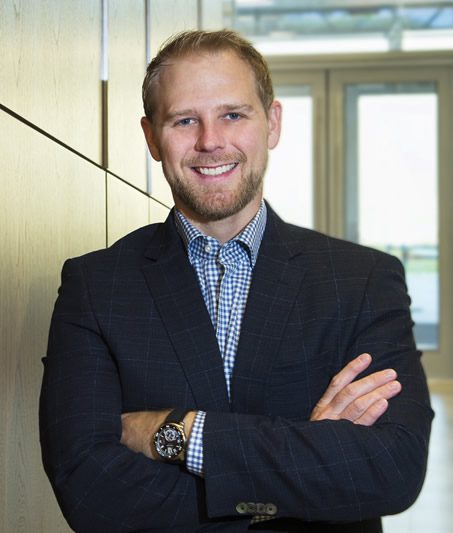
by Dr. Christopher Good, M.D.
President, Virginia Spine Institute
